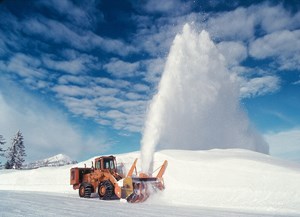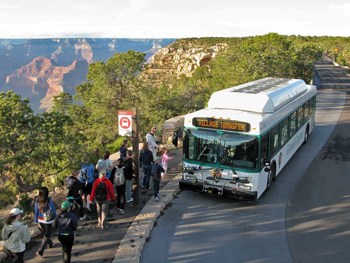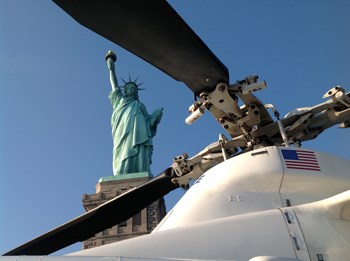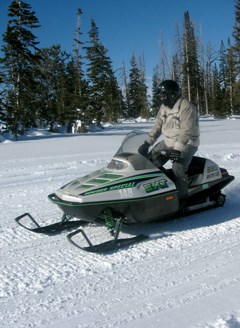The NPS works to improve soundscapes in national parks so that you and other park visitors can better experience the natural park environment, and wildlife can better hear and communicate for survival. Parks employ science research, best management practices, and quiet technologies to reduce disruptive sound levels and optimize the natural soundscape environment.
Sound types and levels in parks vary and come from inside and outside park boundaries. The Natural Sounds and Night Skies Division works with parks to assess the quality of the park soundscape and recommend solutions for managing sound-related issues and preserving vulnerable soundscapes. And the NPS coordinates with other federal agencies, communities, and private organizations to find cooperative solutions. You, your friends and family, and other park visitors can also make a difference through mindful engagement in parks.

NPS Photo
Park Operations
- Park operations can impact a park’s sound environment. Snow plows, construction, grounds care, buildings, and aircraft are among the sources of noise that may come from park operations.
- Some noise is unavoidable, but NPS management policies require parks to "monitor mechanical noise that adversely affects opportunities to enjoy park soundscapes."
- Parks may choose quieter tools for a job when possible, such as a handsaw in place of a chainsaw in wilderness areas.Quieter motorized tools and vehicles are often more energy-efficient, making them a great choice for parks concerned about emissions. Generators may be replaced or supplemented by batteries or solar power.
- Noisy equipment may be relocated away from noise-sensitive areas, or scheduled at times of the day or year when they will have the least impact on activities such as interpretive programs and/or wildlife.

NPS Photo
Transportation
- Cars, motorcycles and other motor vehicles are often the most dominant and pervasive noise sources in parks. They may: 1) cause delays and backups, which detract from the visitor experience; 2) negatively impact wildlife through collisions, habitat fragmentation, and noise; and 3) contribute to air pollution. Our division works with parks to educate visitors on the importance of respectful and responsible vehicle use.
- Shuttles and park buses are effective alternatives to single family vehicle use that reduce vehicle congestion and noise. Zion National Park is an example of a park that adopted shuttles to ferry visitors through the park landscape to trailheads and other destinations. Zion visitors comment that the park experience is much more serene without the presence of cars. Restored tranquility also affects wildlife health and behavior. Whereas animals avoid main roads with heavy vehicle usage, visitors report increased wildlife sightings in parks with regulated vehicle use.
- Energy-efficient hybrid and electric vehicles are quieter than gas-powered vehicles; their use is encouraged in parks, when possible.
- The NPS installs electronic, traffic display signs in national parks. These custom-built, solar-powered signs record and display the sound levels of passing vehicles to encourage motorists to slow down, which, in turn, lowers the volume of their vehicles. Learn about NPS noise traffic signs.
- Motorcycle riding is a popular way to experience National Parks. Riders enjoy the feeling of freedom and connection to nature as they cruise through the landscape. Motorcycles are also louder and emit more low-frequency sounds than most automobiles. Excess motorcycle noise travels greater distances across the landscape, resulting in a greater impact to wildlife and visitors. Learn about "Ride Respectfully" for motorcycle usage in the parks.
- Duration:
- 3 minutes, 11 seconds
This video explains the importance of natural sounds to the visitor experience, wildlife behavior and health, and how replacing the shuttles with electric vehicles continues to improve the park’s soundscape.

NPS Photo by Zeph Cunningham
Aircraft
- Air tours offer a unique perspective on national parks and are popular among visitors. General aviation, commercial flights, military flights, fire and emergency flights, scientific and maintenance flights may also occur over parks. Noise from these aircraft disturbs visitors, culturally sensitive areas, and wildlife on the ground.
- With the National Parks Air Tour Management Act (NPATMA), the Federal Aviation Administration (FAA) and the National Park Service work together to mitigate or prevent adverse impacts to park resources and values. All factors are considered. Air Tour Agreements with air tour operators bring positive solutions for balancing park needs with visitor enjoyment. Visit the Air Tours pages of the Overflights section of our website to learn more.
- Adjacent airfields to parks and expansion of airports also have the potential to impact parks, such as when flight paths coincide with backcountry trails or wildlife migration areas. An examination of the acoustic environment is addressed at all levels of park planning to ensure the implementation of thoughtful and sustainable solutions for protecting park soundscapes. For example, Denver International Airport and Rocky Mountain National Park developed a cooperative plan that modified airplane flight paths so that traffic above did not disrupt resources below.
- The NPS collaborates with the U.S. Military to balance needs for military training flights and protection of park resources and visitor experiences. The jointly developed United States Air Force and National Park Service Western Pacific Regional Sourcebook is an outstanding example of a cooperative relationship that helps both agencies better address military overflights.
- Duration:
- 3 minutes, 43 seconds
This video tells the story of how noise affects the park and measures taken to mitigate noise levels. The video explains the importance of natural sounds to the visitor experience, the role of acoustic monitoring in managing resources, and how the NPS worked with FAA to protect the park’s wilderness character.

NPS Photo
Recreation
Snowmobiles
- Before their numbers were limited, one could count as many as 1,500 snowmobiles a day in Yellowstone National Park. In a 2000 National Parks Conservation Association study, the machines could be heard 90 percent of the time at eight popular sites (National Park Conservation Association & Greater Yellowstone Coalition Yellowstone, 2000).
- In addition to the pervasive noise, snowmobile use impacts wildlife, air and water quality, and one of the park's most alluring values—its wildness. Yellowstone established Winter Use Plan guidelines that set effective limits on snowmobile use in parks. For example, commercial guides must now lead all tours, and use cleaner and quieter machines. In the years following the regulations, Yellowstone staff has measured some of the quietest conditions ever recorded in the park. The park is a model for others where snowmobiles are used. The NPS continues to collect acoustical data, and model potential noise impacts of snowmobile use to provide guidance on this issue.
- Acoustical data plays a role in managing ORVs in national parks. By superimposing the noise footprint and intensity of selected activities over area maps, noise mapping models help park managers better understand how and where noise travels.
- The NPS has determined that personal watercraft (PWC) use has a direct and adverse effect on park values, such as peace and quiet. In April 2000, a ruling prohibited PWCs in areas of the National Park System. The rule also recognizes that PWC use may be appropriate in certain parks or portions of areas in parks. In the case of Lake Mead (AZ/NV) and Glen Canyon (AZ/UT) National Recreation Areas (NRAs), Congress directed the NPS to manage an active motorized water-based recreation program on large man-made lakes. In this way, the rule manages regulated PWC use while protecting visitors and park resources. Measuring noise levels of PWCs has helped park managers evaluate impacts and make informed decisions.
Last updated: December 14, 2020
